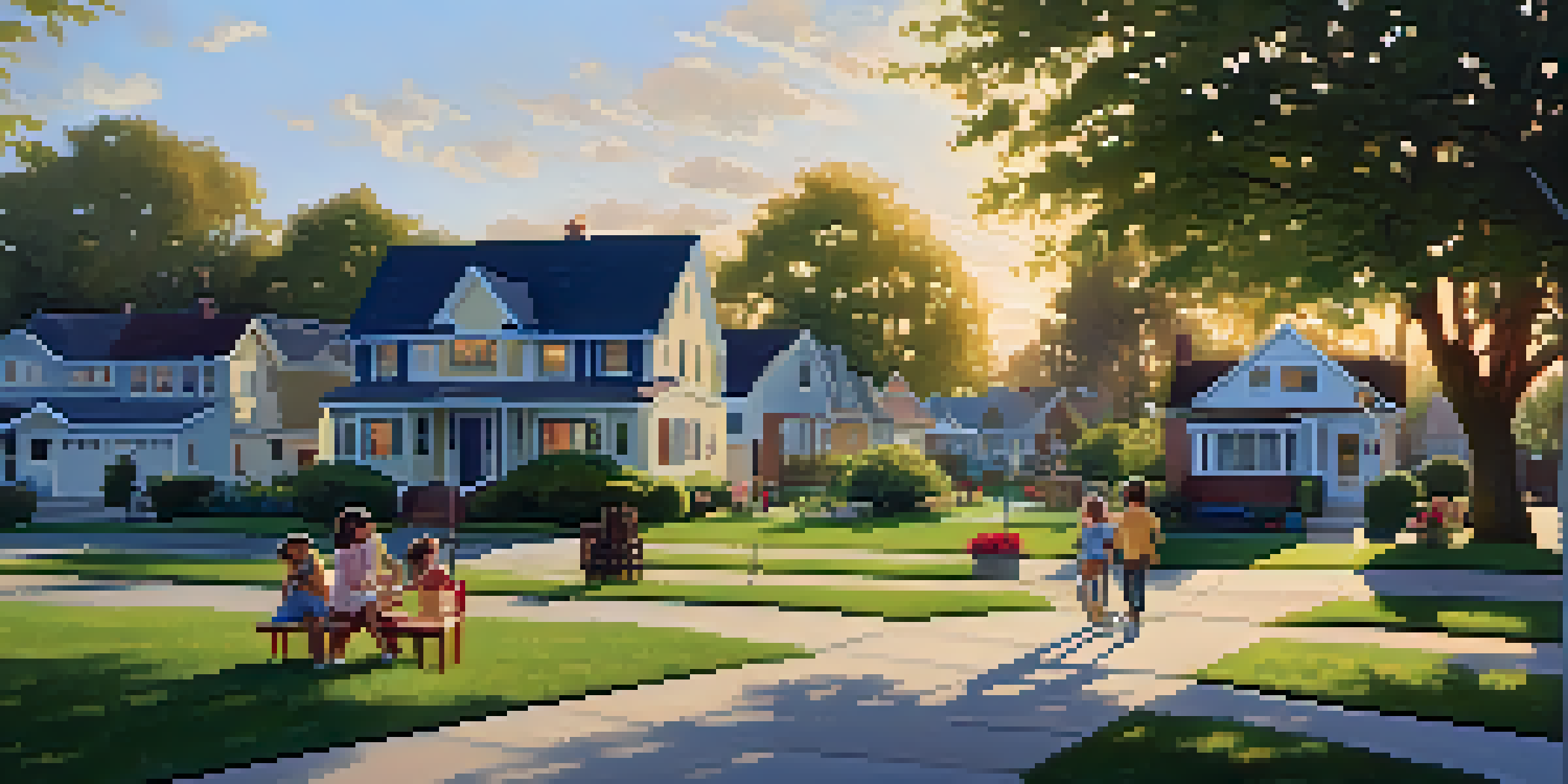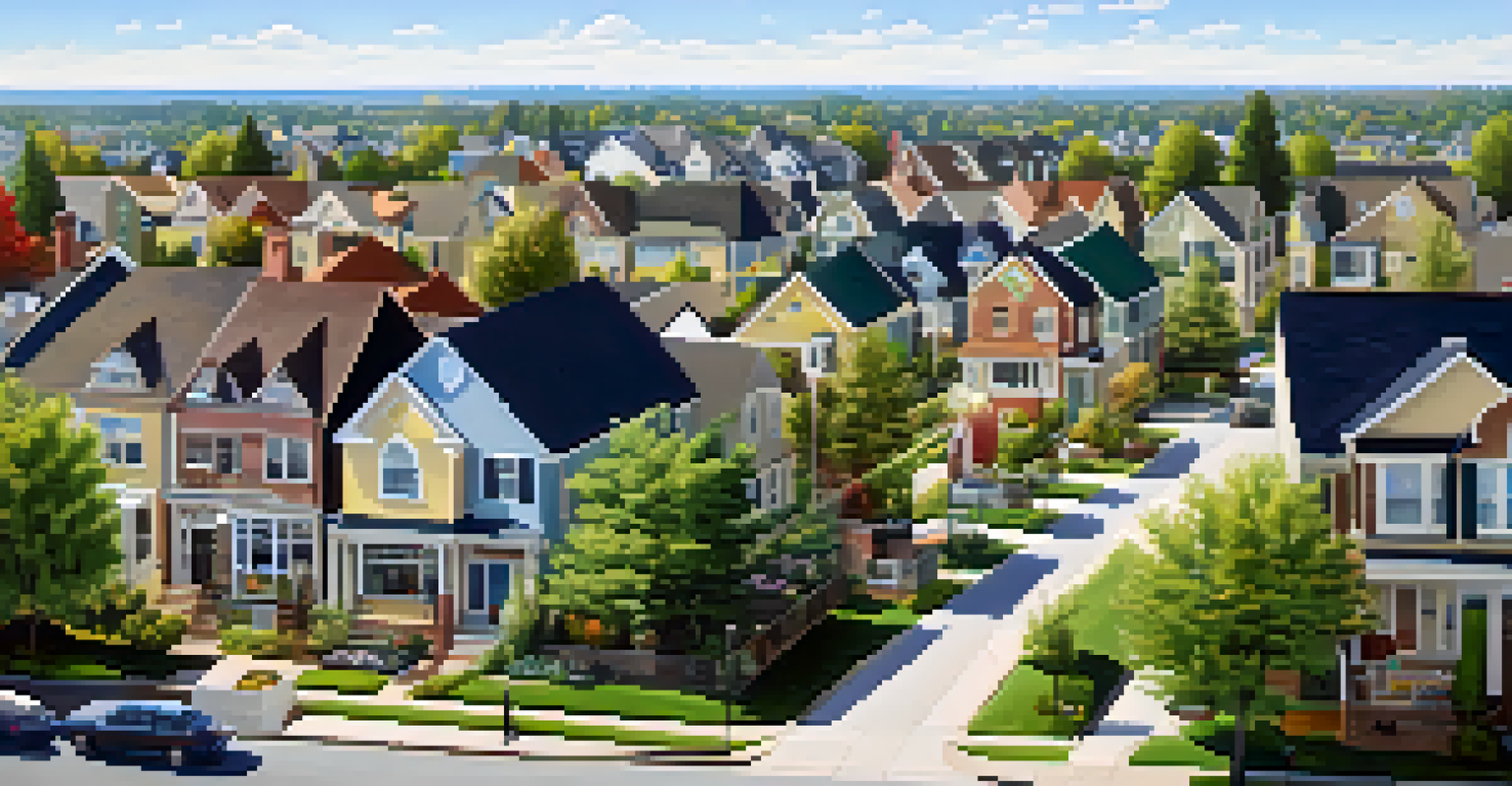Impacts of NYC Migration on Suburban Housing Markets

Understanding the Migration Trends from NYC
In recent years, the trend of New Yorkers moving to suburban areas has gained significant attention. This migration is often driven by a desire for more space, affordability, and a quieter lifestyle, especially in the wake of the pandemic. Many families and professionals are seeking homes that offer amenities like yards and home offices, which are less common in dense urban settings. As a result, suburbs that were once considered sleepy are now becoming vibrant hubs of activity.
The suburbs are a refuge for those seeking space and tranquility, especially in today's fast-paced world.
Interestingly, this shift isn't just about leaving New York City; it's also about the allure of suburban living. Communities that were previously overlooked are now attracting attention due to their charm and potential for growth. As more people consider relocating, the competition for homes in these areas has intensified, leading to changes in local housing markets. This trend showcases the evolving preferences of homebuyers and the impact of urban challenges, such as high rents and limited space.
Moreover, the demographic of those migrating is noteworthy. Younger families, remote workers, and even retirees are all part of this trend, each bringing their unique needs and expectations. This diverse influx is reshaping suburban environments, making them more appealing to a wider range of residents. Understanding these migration patterns is crucial for both real estate professionals and local governments as they adapt to the changing landscape.
Impacts on Housing Demand in Suburban Areas
As more New Yorkers flock to the suburbs, the demand for housing has surged dramatically. This increased demand often leads to rising home prices, making it more challenging for long-time residents and first-time buyers to enter the market. The competition for available properties has created a seller's market, where buyers are frequently faced with bidding wars, pushing prices even higher. Such dynamics can significantly affect the affordability of suburban living.

Additionally, the heightened demand has prompted developers to respond with new construction projects. This boom in development can lead to improved infrastructure, amenities, and services in suburban areas, enhancing the quality of life for all residents. However, it also raises concerns about overdevelopment and the potential loss of green spaces. Striking a balance between growth and preservation becomes essential as communities adapt to these changes.
NYC Migration Boosts Suburban Demand
The influx of New Yorkers into suburban areas has significantly increased housing demand, leading to rising prices and a competitive market.
On the flip side, rising property values can also benefit homeowners, leading to increased equity and investment potential. Many long-term residents may find themselves in a favorable position as their property values appreciate. However, it's important to keep in mind that not everyone in these communities will benefit equally, particularly those on fixed incomes or lower wages, who may feel the strain of rising costs.
Shifts in Housing Supply and New Construction
The influx of New Yorkers into suburban areas has spurred a wave of new construction and development. Builders are responding to the demand for single-family homes, townhouses, and even multi-family units to accommodate the growing population. This shift is not only transforming the housing landscape but is also influencing the types of homes being built. Developers are increasingly focusing on features such as open floor plans and home offices to meet the needs of modern buyers.
Home is a place where we can be ourselves, and for many, that place is now outside the city.
However, this surge in construction can lead to challenges, particularly in terms of zoning regulations and community opposition. Many residents may be concerned about the changes to their neighborhoods, fearing that new developments could impact their quality of life. Striking a balance between growth and community input is crucial, as local governments work to ensure that new housing meets the needs of both current and future residents.
Moreover, the rise in new construction can also affect the rental market. As more families seek to buy homes, the demand for rental properties may decline, potentially leading to lower rental prices. However, this effect may vary by region, depending on local economic conditions and the overall demand for housing. Understanding these dynamics is essential for anyone looking to invest in suburban real estate.
Effects on Local Economies and Services
The migration of NYC residents to suburban areas has profound implications for local economies. As new residents settle in, they bring with them spending power that can stimulate local businesses. From grocery stores to restaurants, these newcomers are contributing to the economic vitality of their new communities. This influx can lead to job creation and the expansion of services, benefiting everyone in the area.
However, rapid population growth can also strain local infrastructure and services. Schools, public transportation, and healthcare facilities may face increased demand, which can challenge existing systems. Local governments must plan proactively to accommodate these changes, ensuring that services keep pace with the growing population. This planning can involve everything from expanding public services to investing in infrastructure improvements.
Remote Work Drives Suburban Living
The rise of remote work has allowed many individuals to relocate to suburbs, seeking homes that better fit their lifestyle preferences.
Additionally, the demographic diversity introduced by newcomers can lead to cultural shifts within suburban communities. Long-established neighborhoods may find themselves evolving, with new ideas, cuisines, and traditions enriching the local culture. This blending can foster a sense of community and enhance the overall appeal of suburban living, making it a vibrant place for both new and long-term residents.
Challenges for Long-term Residents
While the migration from NYC brings many benefits, it also poses challenges for long-term residents in suburban areas. As housing prices rise and demand increases, many existing homeowners may feel the pressure of a changing market. For those on fixed incomes, this could mean facing higher property taxes and increased living costs, which can lead to financial strain. Understanding these dynamics is essential for community leaders and policymakers.
Moreover, the influx of new residents can sometimes lead to a sense of displacement among long-time locals. As neighborhoods evolve, the character and culture of a community may change, potentially alienating those who have called it home for years. Striking a balance between welcoming newcomers and preserving the essence of a community requires thoughtful planning and engagement with all residents.
Additionally, long-term residents may find themselves competing with newcomers in the housing market, especially if they are looking to downsize or move elsewhere. This competition can drive up prices even further, making it difficult for them to find affordable options. Addressing these challenges will be crucial to maintaining the diversity and stability of suburban communities.
The Role of Remote Work in Migration Patterns
The rise of remote work has significantly influenced migration trends, enabling many New Yorkers to consider suburban living for the first time. With the ability to work from anywhere, individuals and families are no longer tethered to the city, allowing them to seek homes that align better with their lifestyle preferences. This newfound flexibility has broadened the options available to many, sparking interest in areas that were previously overlooked.
As remote work continues to shape the workforce landscape, it is likely that suburban areas will see sustained interest from urban dwellers. The demand for homes with office spaces, access to nature, and family-friendly amenities is expected to remain strong. This shift highlights the importance of accommodating modern work-life balance in suburban housing developments and community planning.
Challenges for Long-term Residents
Long-term residents face challenges such as rising housing costs and potential displacement as new residents move into suburban communities.
However, the remote work trend is not without its challenges. Suburbs must ensure they develop the necessary infrastructure, such as high-speed internet and co-working spaces, to support this influx of remote workers. Communities that prioritize these investments will be better positioned to attract and retain new residents, fostering a thriving economy and lifestyle.
Future Outlook for Suburban Housing Markets
Looking ahead, the future of suburban housing markets will likely continue to be shaped by migration trends from NYC and other urban centers. As remote work remains prevalent and families seek out more space, it's expected that suburban demand will stay robust. This ongoing interest may lead to further development and innovation in housing solutions that cater to the evolving needs of residents.
However, local governments and real estate developers will need to be mindful of the balance between growth and sustainability. Ensuring that new developments are environmentally responsible and that community needs are met will be vital to maintaining the appeal of suburban living. Engaging with residents during planning processes can help create inclusive communities that benefit everyone.

In conclusion, the impacts of NYC migration on suburban housing markets are complex and multifaceted. As this trend evolves, it will continue to shape the character, economy, and landscape of suburban areas. By understanding these dynamics, stakeholders can work together to create vibrant communities that welcome both newcomers and long-time residents alike.